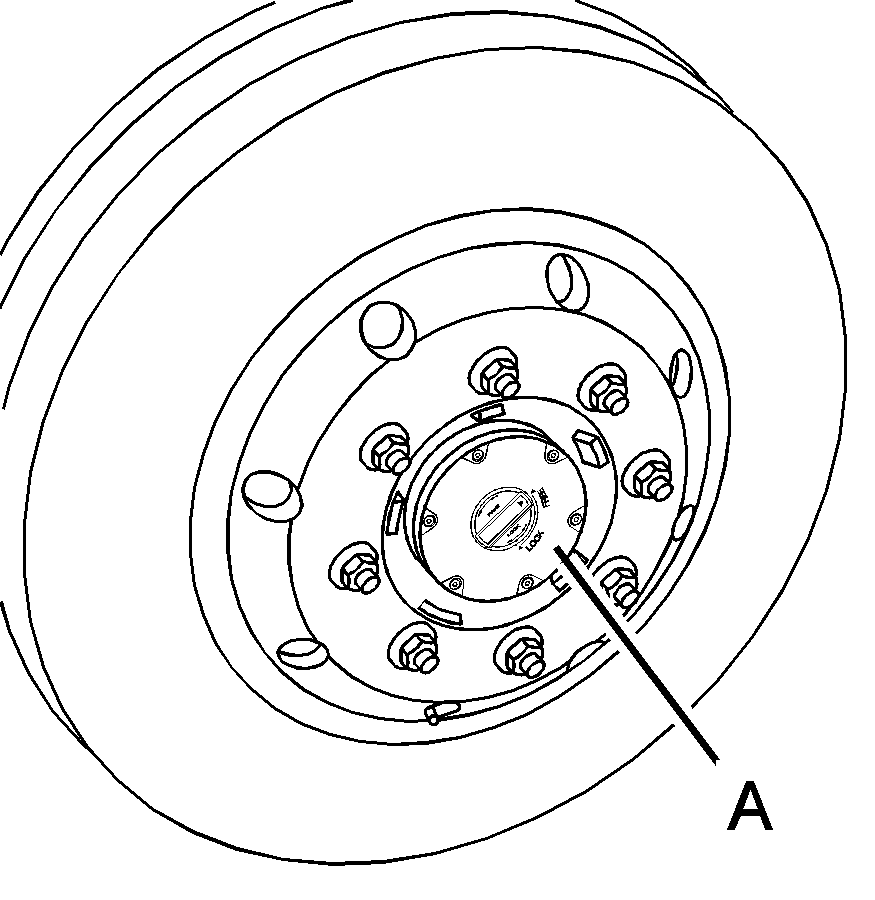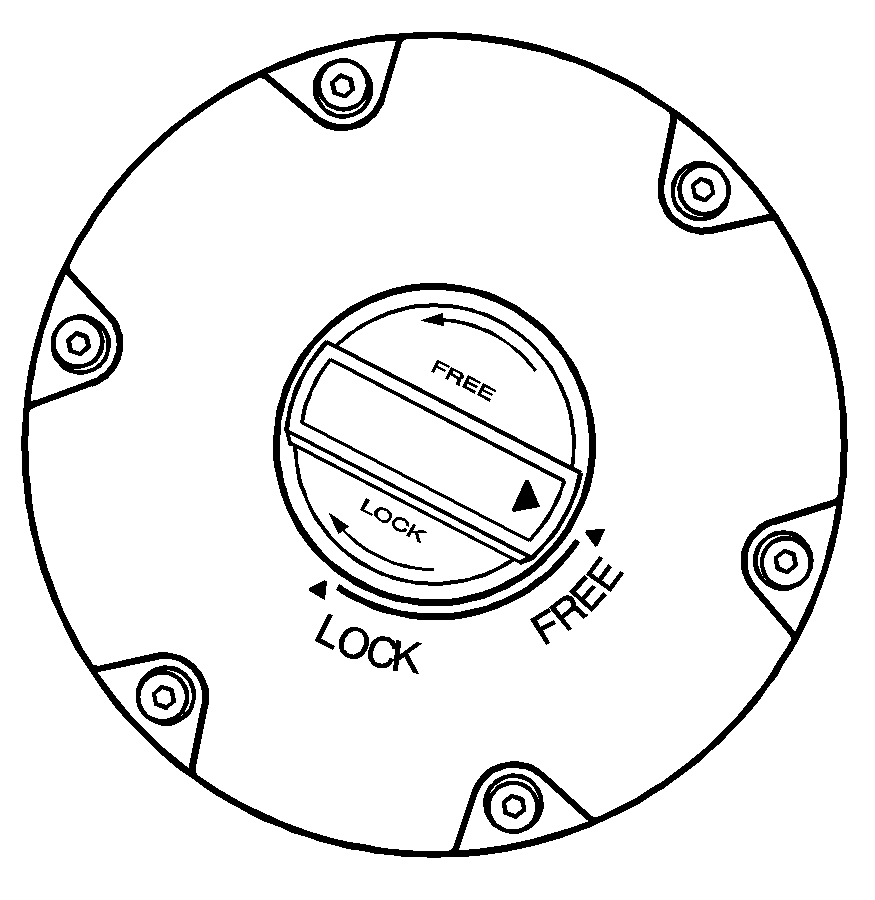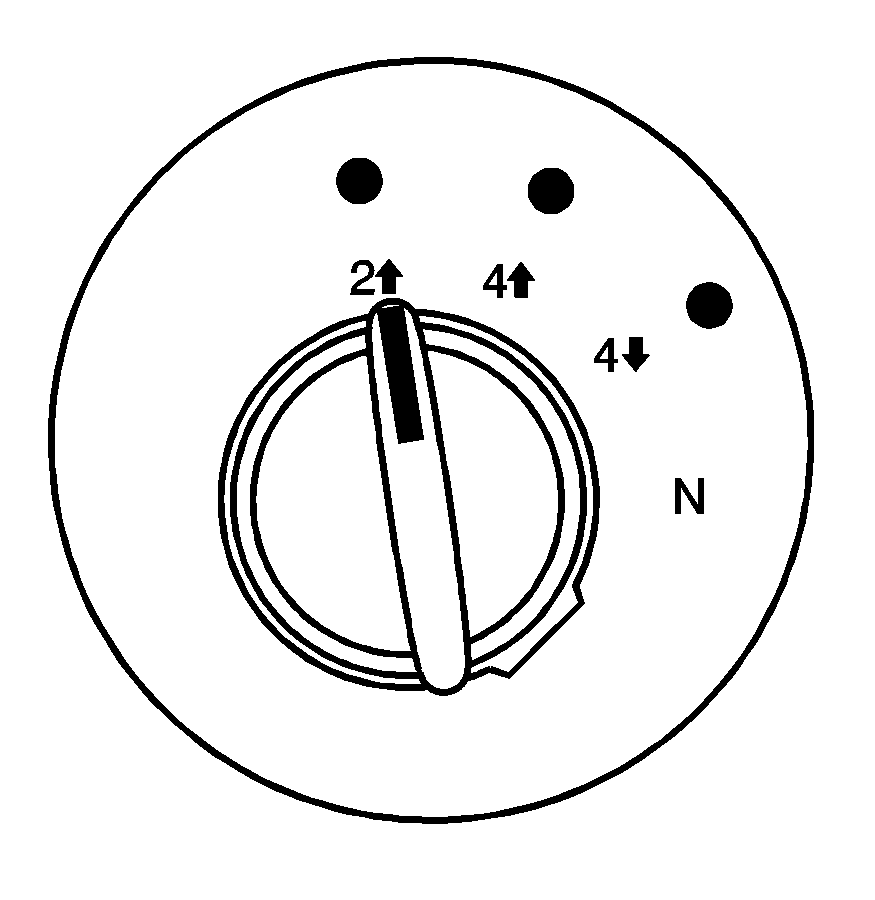If the vehicle has four-wheel drive, you can send the engine's driving power to all four wheels for extra traction. To get the most satisfaction out of four-wheel drive, you must be familiar with its operation. Read the part that follows before using four-wheel drive. You should use two-wheel drive high for most normal driving conditions.
Notice: Driving on clean, dry pavement in four-wheel drive for an extended period of time can cause premature wear on the vehicle's powertrain. Do not drive on clean, dry pavement in Four-Wheel Drive for extended periods of time.
Locking Hubs
Hublock Dial Location

Hublock Dial

Turn the dial of the hublock (A) from the FREE position to the LOCK position to lock the front axle.
Turn the dial of the hublock (A) from the LOCK position to the FREE position to unlock the axle.
You do not have to back the vehicle up to disengage the hublocks.

If the vehicle has four-wheel drive, the transfer case knob is located to the right of the steering wheel on the instrument panel. Use this knob to shift into and out of four-wheel drive.
An indicator light shows you which position the transfer case is in. The indicator lights come on briefly when you turn on the ignition and one stays on. If the lights do not come on, you should take the vehicle to your dealer/retailer for service. An indicator light flashes while shifting the transfer case. It will remain on when the shift is complete. If for some reason the transfer case cannot make a requested shift, it returns to the last chosen setting.
Driving Conditions | Transfer Case Settings | |||
|---|---|---|---|---|
2 | 4 | 4 | N | |
Normal | YES |
|
|
|
Severe |
| YES |
|
|
Extreme |
|
| YES |
|
Vehicle in Tow* |
|
|
| YES |
*See Towing Your Vehicle for further information. | ||||
4 (Four-Wheel High): Use Four-Wheel High when you need extra traction, such as on snowy or icy roads or in most off-road situations. Be sure the front wheel hubs are locked when you want to drive in Four-Wheel High.
4 (Four-Wheel Low): This setting sends maximum power to all four wheels. You might choose Four-Wheel Low if you are driving off-road in deep sand, deep mud, and climbing or descending steep hills. Be sure the front wheel hubs are locked when you want to drive in Four-Wheel Low.
Caution: Shifting the transfer case to Neutral can cause the vehicle to roll even if the transmission is in P (Park). You or someone else could be injured. If you are going to leave the vehicle, set the parking brake and shift the transmission to P (Park) and make sure the transfer case is in a drive gear.
Notice: If the vehicle has an Allison® transmission and you try to put the transmission in P (Park) while the transfer case is in Four-Wheel Low, the transmission might not go into P (Park) and could damage the vehicle. When parking the vehicle, make sure the transfer case is in Two-Wheel High or Four-Wheel High.
N (Neutral): Shift the vehicle's transfer case to N (Neutral) only when towing the vehicle.Shifting Into Four-Wheel High
Turn the knob to four-wheel high. This can be done at 3 mph or less. The indicator light flashes while shifting. It remains on after the shift is complete. Be sure to lock the front hubs.
Shifting Into Two-Wheel High
Turn the knob to Two-Wheel High. This can be done at 3 mph or less.
Shifting Into Four-Wheel Low
To shift to Four-Wheel Low, the vehicle's engine must be running and the vehicle must be stopped or moving less than 3 mph (5 km/h) with the transmission in N (Neutral). The preferred method for shifting into Four-Wheel Low is to have the vehicle moving 1 or 2 mph (1.6 to 3.2 km/h). Turn the knob to Four-Wheel Low. You must wait for the Four-Wheel Low indicator light to stop flashing and remain on before shifting the transmission into gear. Be sure to lock the front hubs.
Notice: Shifting the transmission into gear before the Four-Wheel Drive Low indicator light has stopped flashing could damage the transfer case. To help avoid damaging the vehicle, always wait for the Four-Wheel Drive Low indicator light to stop flashing before shifting the transmission into gear.
If you turn the knob to Four-Wheel Low while the vehicle is in gear and/or moving, the Four-Wheel Low indicator light flashes for 30 seconds and does not complete the shift unless the vehicle is moving less than 3 mph (4.8 km/h) and the transmission is in N (Neutral). After 30 seconds, the transfer case returns to the setting last chosen. If the vehicle is in gear and moving less than 3 mph (4.8 km/h), the transfer case shifts to Four-Wheel High.
Shifting Out of Four-Wheel Low
To shift from Four-Wheel Low to Four-Wheel High or Two-Wheel High, the vehicle must be stopped or moving less than 3 mph (5 km/h) with the transmission in N (Neutral) with the engine running. The preferred method for shifting out of Four-Wheel Low is to have the vehicle moving 1 or 2 mph (1.6 to 3.2 km/h). Turn the knob to Four-Wheel High or Two-Wheel High. You must wait for the Four-Wheel High or Two-Wheel High indicator light to stop flashing and remain on before shifting the transmission into gear.
Notice: Shifting the transmission into gear before the Four-Wheel High or Two-Wheel High indicator light has stopped flashing could damage the transfer case. To help avoid damaging the vehicle, always wait for the Four-Wheel High or Two-Wheel High indicator light to stop flashing before shifting the transmission into gear.
If the knob is turned to Four-Wheel High or Two-Wheel High while the vehicle is in gear and/or moving, the Four-Wheel High or Two-Wheel high indicator light flashes for 30 seconds. It will not complete the shift unless the vehicle is moving less than 3 mph (5 km/h) with the transmission in N (Neutral).
Shifting Into Neutral
Before shifting the transfer case to N (Neutral), first make sure the vehicle is parked so that it will not roll.
- Set the parking brake. See Parking Brake for parking brake apply procedure.
- Start the vehicle.
- Put the transmission in N (Neutral).
- Shift the transfer case to Two-Wheel High.
- Turn the transfer case knob all of the way past Four-Wheel Low and hold it there for a minimum of 10 seconds. The N (Neutral) indicator light comes on.
- Shift the transmission to R (Reverse) for one second, then shift the transmission to D (Drive) for one second.
- Turn the ignition to OFF.
- Place the transmission shift lever in P (Park).
- Turn the ignition to LOCK.
Shifting Out of Neutral
To shift the transfer case out of N (Neutral), do the following:
- Set the parking brake. See Parking Brake for parking brake apply procedure.
- Apply the regular brake pedal.
- Turn the ignition to ON/RUN with the engine off.
- Put the transmission in N (Neutral).
- Turn the transfer case knob to the desired shift position (Two-Wheel High, Four-Wheel High, Four-Wheel Low).
- After the transfer case has shifted out of N (Neutral), the indicator light goes out.
- Release the parking brake.
- Start the engine and shift the transmission lever to the desired position.
Notice: Driving with the parking brake on can overheat the brake system and cause premature wear or damage to brake system parts. Verify that the parking brake is fully released and the brake warning light is off before driving.
Excessively shifting the transfer case into or out of the different modes can cause the transfer case to enter the shift protection mode. This protects the transfer case from possible damage and only allows the transfer case to respond to one shift per 10 seconds. The transfer case can stay in this mode for up to three minutes.
